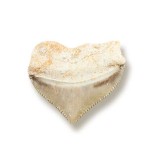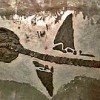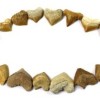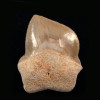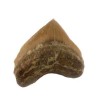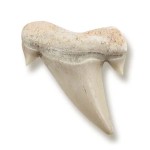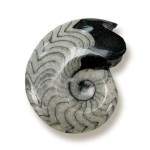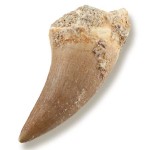Product Description
FOUND IN: NORTH AMERICA, EUROPE, NORTH AFRICA, AUSTRALASIA.
These sharks are of medium size, up to 5 meters in length (usually smaller – 2 meters). The body were similar to the modern gray sharks, but the shape of the teeth is strikingly similar to that of a tiger shark. The teeth are numerous, relatively small, with a curved crown and serrated, up to 2.5 – 3 cm in height (the only representative of the MesozoicLamniformes with teeth). Large numbers of fossil teeth have been found in Europe, North Africa, and other parts of North America.
Squalicorax was a coastal predator, but also scavenged as evidenced by a Squalicorax tooth found embedded in themetatarsal (foot) bone of a terrestrial hadrosaurid dinosaur that most likely died on land and ended up in the water. Other food sources included turtles, mosasaurs, ichthyodectes and other bony fishes and sea creatures.
Squalicorax is a fossil lamnoid known from late Cretaceous deposits in Kansas, including a splendid six-foot (1.9-metre) articulated specimen. Like many lamnoids, however, Squalicorax is best known from its distinctive teeth. Those of Squalicoraxhave a rectangular root crowned with a graceful, finely serrated blade, shaped rather like a rose thorn. Fossil teeth of Squalicorax are known from deposits dating from the last part of the Cretaceous (100 million to about 65 million years ago) in Europe, north Africa, and North America. From the dimensions of its largest known teeth, the speciesSqualicorax pristodontus was quite sizable, perhaps 15 to 16.5 feet (4.5 to 5 metres) in length and must have been a formidable predator.
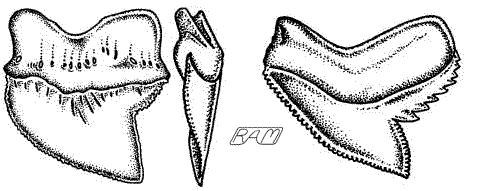
Fossil teeth of the Crow Shark (Squalicorax kaupi), (left and center images), resemble those of the modern Tiger Shark (Galeocerdo cuvier), (right). Although the Tiger Shark is notorious as an indiscriminate scavenger, studies of its dietary habits have revealed that it is primarily a fish-eater. While there is compelling evidence that Squalicorax scavenged on occasion, it seems unlikely that it relied on this food source any more than does the Tiger Shark.
Squalicorax apparently also scavenged, a feeding mode that has earned them the name “crow sharks” in some circles. Paleontologist David Schwimmer and his co-workers have found direct evidence of Squalicorax scavenging, including a decayed mosasaur vertebral centrum with an embedded Squalicorax tooth and many tooth-scarred tetrapod bones. Recently, Schwimmer found a fossilized Squalicorax tooth embedded in a metatarsal (foot) bone of a juvenile hadrosaur (duck-billed dinosaur). Schwimmer speculates that Squalicorax may have relied on scavenging to provide much of its diet and that competition from predatory marine reptiles may have forced these sharks to scavenge carcasses of large creatures – including those of terrestrial animals that somehow ended up in the water, such as the hapless hadrosaur whose remains he found. This may be stretching the fossil evidence a little too far, as remains of fish prey are far more delicate and rarely preserved than those of tetrapods – and most sharks (including the super predatory Great White) will scavenge, given the opportunity.
According to Shimada, another species of Squalicorax, S. falcatus, scavenged its larger cousin, Cretoxyrhina mantelli. Other food items of S. falcatus include turtles, mosasaurs, the mackerel-like Ichthyodectes, and the swordfish-like Protosphyraena. Shimada suggests that in their broad-spectrum diet, Squalicorax resembled the modern Tiger Shark (Galeocerdo cuvier). In any case, little else is known about Squalicorax. Even having articulated remains with which to work, paleontologists are uncertain howSqualicorax is related to other lamnoids.

